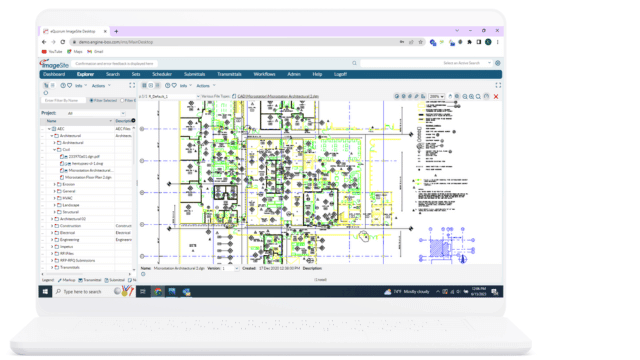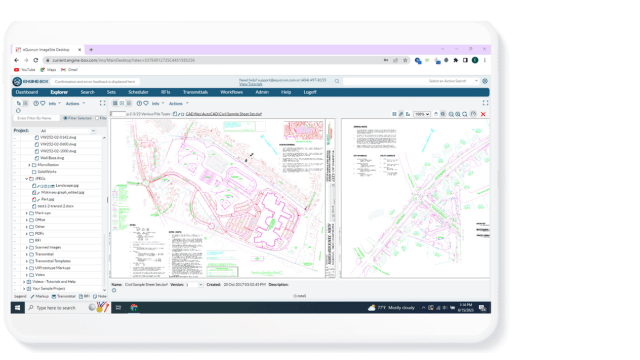6 Reasons To Use an Engineering Document Management System
6 Reasons To Use an Engineering Document Management System
For many years, organizations have relied on the use of documents to maintain records of projects and communications. For much of the 20th century, paper documents were put into filing cabinets for storage so they could be referenced, when needed. But, with advances in digital technology, companies now rely on their computer systems to store and transfer information. So, you may question, “Great, we have all our files stored on our servers and laptops, why do we need an engineering document management system?”
Great question!
Unlike traditional methods of digital document storage, an engineering document management system (DMS) allows workers to store information in a centralized location and provides users with a multitude of functions including structuring, indexing, versioning, distribution, and synchronization. On top of all this, a DMS creates a layer of needed security between proprietary information and nefarious criminals attempting to gain access to information.
Many document management systems also provide document-centric workflow management functionality. This includes the ability to establish a disciplined routing and approval system where employees are given tasks to complete with deadlines, but more importantly are provided the digital files they need to do their job. Project managers and administrators can oversee, manage, and analyze these workflows to improve the speed of completion and reduce errors.
Here are the top 6 reasons you should be using an engineering document management system:

Security and Access Control
Ensure the integrity and safety of your intellectual property and improve the process of how documents, files and data are used, shared and secured.
1. Data Security
First, let’s talk about the basics.
Many people are unaware of the dangers that come with computerized files. Cyber-criminals are working around the clock to find creative ways to get access to your files.
Some of the most common cyber-attacks include:
• Malware
• Phishing
• Man-in-the-middle (MITM)
• SQL injection
In addition, non-encrypted files on local computers, in emails, or on tablets and smartphones can easily be copied either while at rest or in transit. Once copied, files can be used for many ugly outcomes, including corporate hostage-taking and competitors getting your product designs.
Document management solutions keep control of files in more secure locations than local computer drives or even network shares. Many allow users to manipulate files without ever downloading the file, such as for viewing, editing, printing, and providing links to files rather than sending the actual files. Keeping tight control of files is the first and most important security control.
This is why data security is at the heart of high-quality document management systems.
2. Access Control and Compliance
Second, compliance is certainly something you should think about.
Any organization dealing with the federal government, especially DoD prime contractors, must comply with government standards, particularly NIST SP 800-53.
The National Institute of Standards and Technology (NIST) standards are recognized by IT security, compliance, and risk management professionals in varying industries as the standards for best practices.
Access Control is an important feature that any good engineering document management system should have since it uses the core security principals of “least privilege” and “least functionality.”
To put it simply, users should only have access to the documents they need, and should not be able to manipulate information that doesn’t pertain to their work directly.
3. Efficiency
It’s no surprise that engineering document management software is designed with efficiency in mind. Having a quick way for workers to view and transfer their files, not only makes managing workflows easier for employees but also increases the speed in which projects are completed, giving companies a faster path to ROI.
Time to market (TTM) is everything nowadays, so if you can’t complete your projects “lightning fast,” the competition will surely leave you in the dust.
4. Better Backups
We’ve all been there. We’re in the middle of typing that important proposal and suddenly our computer crashes, deleting hours of mentally draining work, leaving us stressed and defeated.
A well-designed document management system offers a place for users to store backups, preventing any unwanted disasters from occurring, archiving files automatically based on time and retention policies.

Document Version Control
Track document changes, capture key decisions and document the reviewing process. Stay in-control of essential workflows while ensuring correct versions of files are being used.
5. Version Control
In the engineering world, documents undergo revisions and redrafting before they can be finalized. Often, changes to these documents can be subtle and are not immediately apparent.
Version control allows users to distinguish between different versions of a draft, while also giving workers the ability to approve or edit changes.
Advanced version control software gives employees a single source of truth across teams, making it easier for development teams to find the most current files and audit changes.
6. Supporting the Correct File Types
It’s important to note not all engineering document management systems have the same functionality. If your company primarily relies on engineering content, you need to be able to support the correct file types (e.g. many engineering document management systems are designed to support CAD files for major 2D/3D CAD products such as AutoCAD, Inventor, MicroStation and SolidWorks, without the need for any third-party software).
More and more we see the use of video and audio files to help in the workflow completion and being able to attach and then view/hear these files while also viewing the underlying document or drawing makes processing less error-prone and can increase the speed of completion.
Summary
Engineering document management systems are software designed to solve complex workflow and document management problems. Document management solutions can effectively help users improve efficiency, security, control, and file distribution, while also ensuring documents are backed-up and stored in compliance with federal regulations.
Additional EDMS Features
Our EDMS solutions
ImageSite and EngineBox are eQuorum’s robust workflow and document management solutions, created to help workers manage their essential workflows while maintaining complete control over their engineering files and documents. Not only do they provide a secure collaboration site for workers, but they also help organizations manage document distribution with third parties like vendors, contractors, and customers. Both systems are offered at a competitive price, enabling organizations to get a quick return on their investment by providing the features and functionality needed to help organizations improve efficiency, productivity, and collaboration. Companies can choose from concurrent user subscriptions or named user subscriptions, ensuring organizations have subscription options that make sense for their business.

ImageSite®
Our single source engineering workflow and document management system. Built in HTML5 so there is no software to deploy to client computers or mobile apps to download. Offered as an On-premise or Private Cloud system.
Our EDMS solutions
ImageSite and EngineBox are eQuorum’s robust workflow and document management solutions, created to help workers manage their essential workflows while maintaining complete control over their engineering files and documents. Not only do they provide a secure collaboration site for workers, but they also help organizations manage document distribution with third parties like vendors, contractors, and customers. Both systems are offered at a competitive price, enabling organizations to get a quick return on their investment by providing the features and functionality needed to help organizations improve efficiency, productivity, and collaboration. Companies can choose from concurrent user subscriptions or named user subscriptions, ensuring organizations have subscription options that make sense for their business.

EngineBox™
EngineBox is a cloud based workflow and document management version of ImageSite that resides outside the corporate network.
The eQuorum Customer Promise
In 2005, eQuorum developed the first all browser-based EDMS. The system, although for on-premise use, was still created to remove client software and JAVA from user computers and allow users to have a single viewer based on the simple navigation functionality of browsers. Today, eQuorum provides that same application in a private Cloud or a SaaS Cloud option. We can do this because we are, and have always been, browser-based, understanding the enhanced speed, security, and usability of this technology.
With the abundance of document management systems on the market today, there’s no doubt that choosing the right Cloud document management software can be a difficult decision. eQuorum is here to provide a comprehensive, powerful, and most importantly – affordable Cloud document management solution. We believe in providing real value to our customers by eliminating unnecessary costs, providing industry-leading functionality, and equipping your team with the right tools using cutting edge technology to bring your products to market faster.
Resources
eQuorum®
We specialize in engineering workflow and document management. Our comprehensive, yet easy-to-use software provides the solution to manage data from design to manufacturing and production, to sales, support and administration.